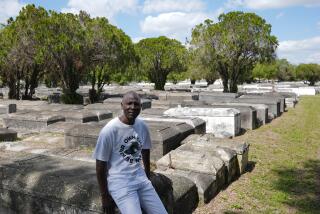Planned City of Future Turns 25 : Not Many Would Be Caught Dead There
- Share via
COLUMBIA, Md. — It is name is virtually synonymous with planning. But 25 years after its founding as America’s first planned city, Columbia belatedly is allowing for the one thing besides taxes that everyone must face--death.
Burying the dead wasn’t on the minds of Rouse Co. officials in 1963 when they purchased 15,000 acres of farmland and mapped out a city of the future. Consultants on recreation, education, sociology and other fields were hired to prescribe ideal living conditions for urbanites weary of depersonalized existence in Washington’s metropolitan sprawl.
But somehow, with its focus on living well, Columbia never made provisions for what comes afterward. This city of 70,500 souls had no cemetery.
“My understanding is that it was overlooked in the beginning. (Rouse Co. founder James) Rouse had very detailed plans. He hired all kinds of experts. The one expert he forgot was a cemetery expert,” said Harvey Geller, who is one.
Last year, the Rouse Co. turned over 28 acres in Columbia to Geller and assigned him to create a graveyard.
Geller was there when the first burial took place.
“We had enough road to accommodate them, luckily. We’ve only cleared about five acres,” Geller said.
In fact, there isn’t much to see of the Columbia Memorial Park--just a circular driveway inside a low, curving stone wall. So far, about 20 plots have been sold and two funerals have been held.
Columbia’s organizers have had little time to think about final resting places. Amenities of gracious living that are in place or on the drawing board include playgrounds, bike and jogging paths, a shopping mall, cultural centers, an athletic club, golf course, community pools and a bowling alley.
In the 1960s, the city--built in rural Howard County 20 miles north of Washington--acquired a reputation for addressing urban problems through innovative, comprehensive planning.
Columbia, which welcomed its first residents in 1967, is seeing its population graying. The people who bought houses in Columbia in their 30s and 40s are approaching retirement.
About 60% of Howard County’s senior citizens now live in Columbia or in nearby Ellicott City, said Bob Callahan, executive director of the Florence Bain Senior Center in Columbia. “It was built as a young persons’ city, but what happened was the old folks came to live near their kids,” Callahan said.
Al Scavo, a Rouse vice president who is overseeing the cemetery, said it has taken two decades for a graveyard to become economically feasible. “I’m not sure it was overlooked. The market wasn’t here,” he said.
It’s still not clear how large that market is. As they approach their twilight years, even residents who love Columbia apparently are not anxious to stay there eternally.
The Rev. Tom Golueke of St. John’s Catholic Church said none of the 2,400 families in his parish has mentioned a desire to be buried in Columbia.
But having a cemetery in the community “does give people some type of roots,” the priest said. “I guess you know you’ve made it as a city when you have a cemetery.”
Columbia residents began to talk about a cemetery in the 1970s, but no developer was interested. Rouse finally ended up doing the first phase of construction itself and giving the land to Geller to manage, Scavo said.
The cemetery is expected to be able to support itself after the 25,000 graves are sold, probably in about 50 years. Cemeteries rely on trust funds financed by plot sales to pay for perpetual maintenance.
The company--a stickler for design rules--had its own ideas about how the tract was to look. Statues, elaborate mausoleums, even simple white crosses were ruled out. Graves will be marked by bronze plates set in the ground, with nothing above ground except landscaping, a small chapel in a grove, and a communal mausoleum.
Gail Saunier, executive director of the Columbia Forum, a citizen watchdog group, said she thinks the cemetery’s time has come.
“It was the one thing we didn’t have,” she said. “If you feel strongly about your community, you may want (to be buried there). I think a lot of people do, and I think that will increase as Columbia gets older.”
More to Read
Sign up for Essential California
The most important California stories and recommendations in your inbox every morning.
You may occasionally receive promotional content from the Los Angeles Times.










